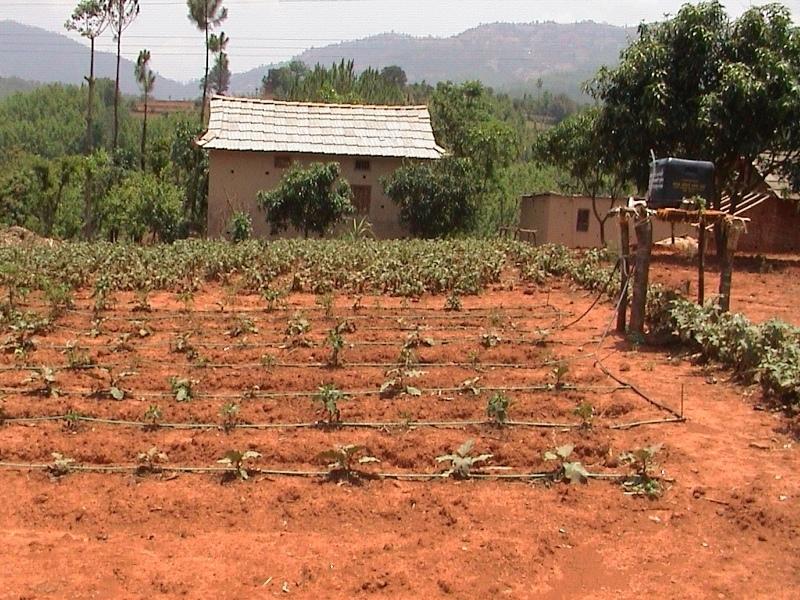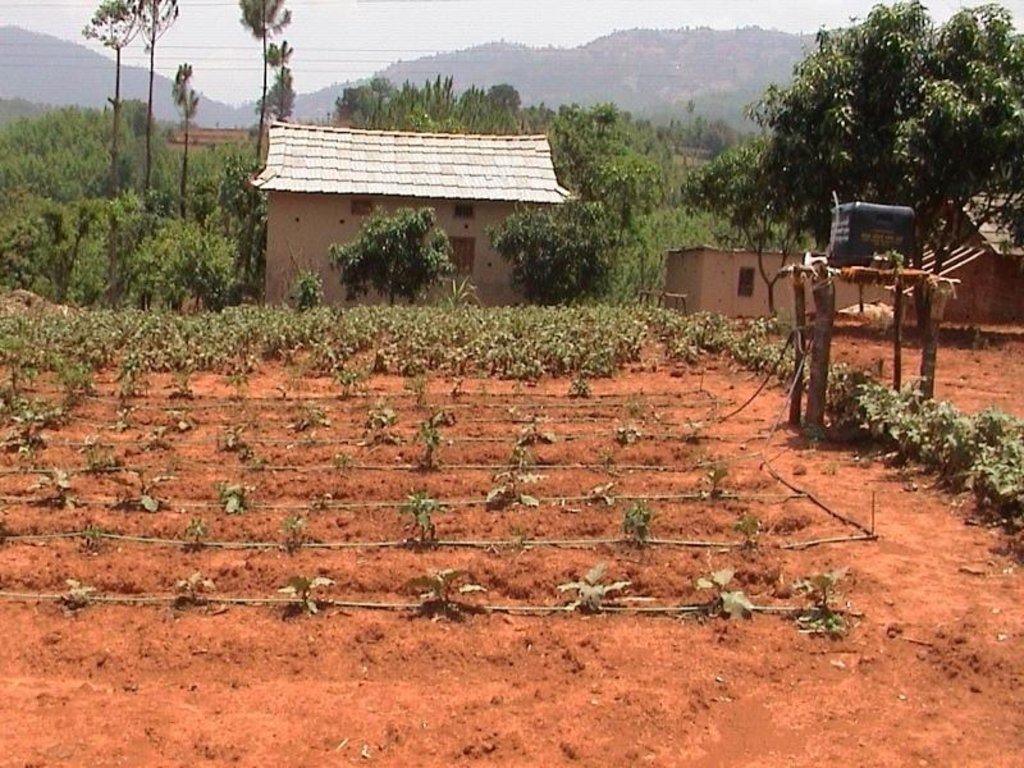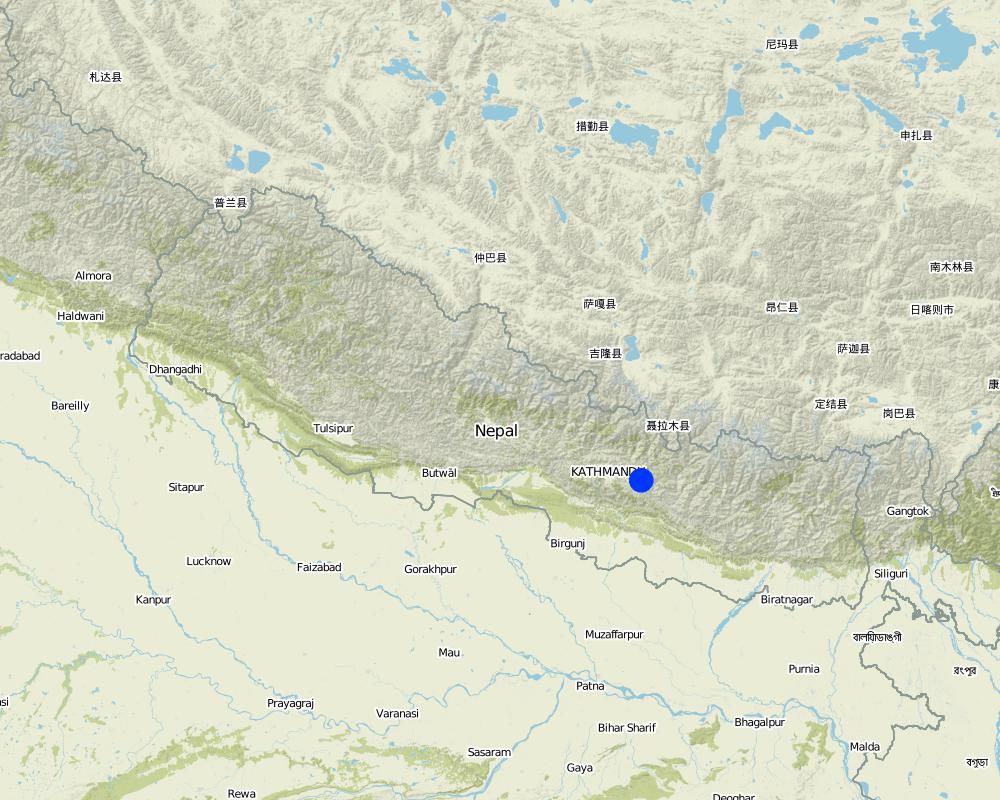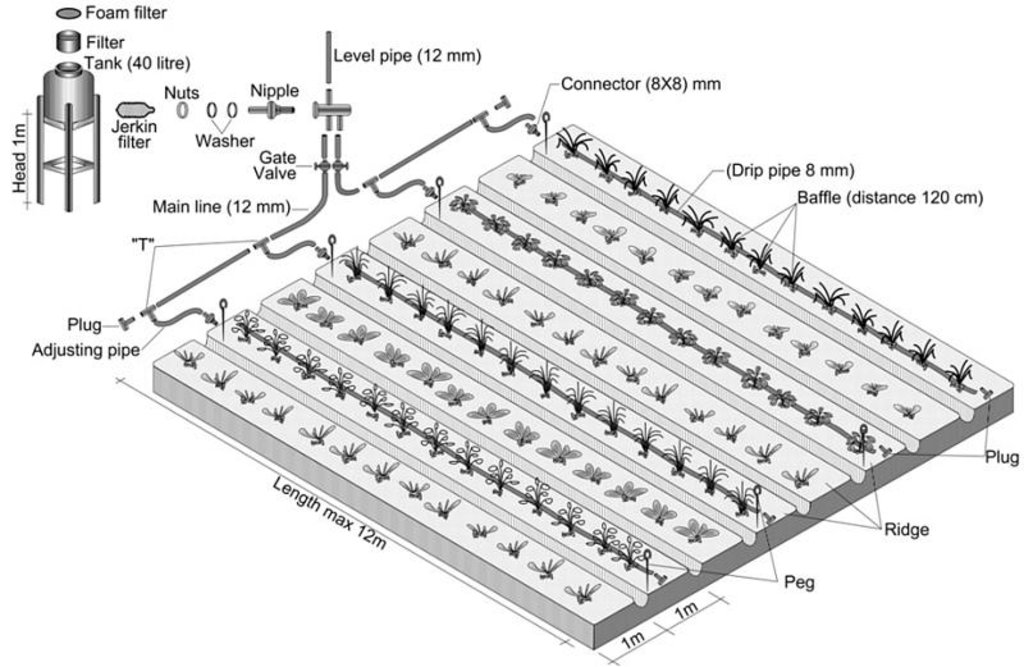Low cost drip irrigation [เนปาล]
- ผู้สร้างสรรค์:
- การอัพเดท:
- ผู้รวบรวม: Madhav Dhakal
- ผู้เรียบเรียง: –
- ผู้ตรวจสอบ: David Streiff, Alexandra Gavilano
Thopa Sichaee (Nepali)
technologies_1501 - เนปาล
ดูส่วนย่อย
ขยายทั้งหมด ย่อทั้งหมด1. ข้อมูลทั่วไป
1.2 รายละเอียดที่ติดต่อได้ของผู้รวบรวมและองค์กรที่เกี่ยวข้องในการประเมินและการจัดเตรียมทำเอกสารของเทคโนโลยี
ผู้เชี่ยวชาญ SLM:
ผู้เชี่ยวชาญ SLM:
Adhikari Krishna
PARDYP/ICIMOD
เนปาล
ผู้เชี่ยวชาญ SLM:
Shrestha-Malla Smita
PARDYP/ICIMOD
เนปาล
ผู้เชี่ยวชาญ SLM:
ชื่อของโครงการซึ่งอำนวยความสะดวกในการทำเอกสารหรือการประเมินเทคโนโลยี (ถ้าเกี่ยวข้อง)
People and Resource Dynamics Project, Nepal (PARDYP)ชื่อขององค์กรซึ่งอำนวยความสะดวกในการทำเอกสารหรือการประเมินเทคโนโลยี (ถ้าเกี่ยวข้อง)
ICIMOD International Centre for Integrated Mountain Development (ICIMOD) - เนปาล1.3 เงื่อนไขการใช้ข้อมูลที่ได้บันทึกผ่านทาง WOCAT
ผู้รวบรวมและวิทยากรหลักยอมรับเงื่อนไขเกี่ยวกับการใช้ข้อมูลที่ถูกบันทึกผ่านทาง WOCAT:
ใช่
1.5 Reference to Questionnaire(s) on SLM Approaches (documented using WOCAT)
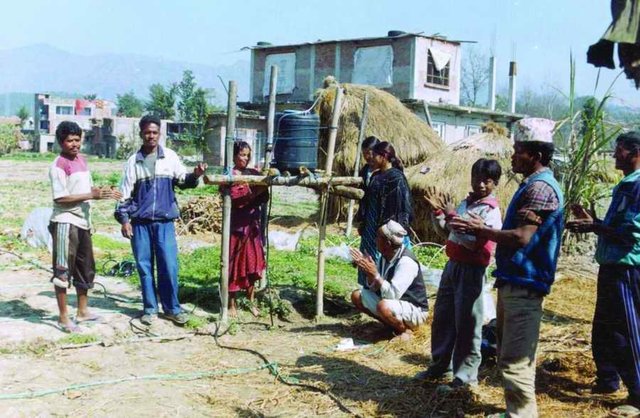
Participatory action research on drip irrigation [เนปาล]
Conducting participatory action research with farmers and line agencies for demonstrating, disseminating and scaling up drip irrigation.
- ผู้รวบรวม: Madhav Dhakal
2. การอธิบายลักษณะของเทคโนโลยี SLM
2.1 การอธิบายแบบสั้น ๆ ของเทคโนโลยี
คำจำกัดความของเทคโนโลยี:
An irrigation system which allows the slow and precise delivery of water to crops
2.2 การอธิบายแบบละเอียดของเทคโนโลยี
คำอธิบาย:
Drip irrigation is a very water-efficient irrigation system. Water is dripped to individual plant root zones at low rates (2.25 l/hr) from emitters embedded in small diameter plastic pipes.
Farmers in the Jhikhu Khola watershed, Nepal, suffer from a shortage of water for irrigation between the end of one monsoon (June to September) and the next pre-monsoon period (May). This seriously limits agricultural production and leads to much land being left fallow after the monsoon crops have been harvested. Only a small area is planted with winter crops. The sources of irrigation water (such as rivers, and streams) are limited and the amount of water they provide is inadequate for cropping. Most of the sources remain dry outside the monsoon. Farmers expend considerable time and labour gathering what water they can to irrigate their crops. Low cost drip irrigation (LCDI) has been introduced in the watershed as a cost effective way of making the best use of the limited available water.
The cropping pattern of this area sees pre-monsoon vegetables established in February and March and winter vegetables in September and October. The low cost drip irrigation sets are installed while the fields are being prepared by ploughing, levelling, and ridging. Lateral pipes (12m long) are laid along the ridges which lie 1.5m apart. A wooden platform with storage tank is installed and connected to the lateral pipes. After the lateral pipes are laid out, planting holes are dug along the ridges spaced to coincide with the drip holes. These holes are usually set every 0.6 or 1.2m along the pipes depending on the crop. Farmyard manure and chemical fertiliser is placed in each pit and mixed well with the soil. Next, vegetable seedlings are planted in each hole and daily drip watering begins. Bitter gourd is the most commonly grown crop followed by cauliflower. Irrigation water is generally applied either in the morning or the evening. If needed, stakes are placed next to each plant a week later to allow the plants to climb. The climber crops like bitter gourd are netted one month after planting to provide more space for fruiting. Harvesting starts in mid-May and continues until September. Farmers maintain the system by repairing leaks in the pipe joints and by unblocking blocked drip holes.
2.3 รูปภาพของเทคโนโลยี
2.5 ประเทศภูมิภาค หรือสถานที่ตั้งที่เทคโนโลยีได้นำไปใช้และได้รับการครอบคลุมโดยการประเมินนี้
ประเทศ:
เนปาล
ภูมิภาค/รัฐ/จังหวัด:
Bagmati zone
ข้อมูลจำเพาะเพิ่มเติมของสถานที่ตั้ง :
Kavepalanchowk/Jhikhu Khola watershed
ระบุการกระจายตัวของเทคโนโลยี:
- กระจายไปอย่างสม่ำเสมอในพื้นที่
If precise area is not known, indicate approximate area covered:
- < 0.1 ตร.กม.(10 เฮกตาร์)
แสดงความคิดเห็น:
The technology was first introduced in the Jhikhu Khola watershed ( JKW) in 1993 with the support from University of British Columbia (UBC) but due to the technical problems it stopped in the same year. The drip sets introduced for the first time was North American type, and spare parts were not available after malfunctioning. Later on , from Oct. 2000 to Jan.2001, UBC again conducted experiments using two different types of drip sets , i.e. LCDI and Western Type ( Stefanie 2002) This experiment was conducted on Cauliflower. People and Resource Dynamics Project with the collaboration of Institute of engineering , Tribhuban University has initiated the drip experiment on cauliflower in Hokse ( Kubinde) in November 1999. In 2000 and 2001 the drip experiments were conducted on bitter gourd at Horticultural center( Panchkhal). From 2001 onwards it was introduced to the farmers field.
For this study, most of the discussions will be concentrated on Bitter gourd grown under drip in Panchkhal.
Map
×2.6 วันที่การดำเนินการ
ถ้าไม่รู้ปีที่แน่นอน ให้ระบุวันที่โดยประมาณ:
- น้อยกว่า 10 ปี (ไม่นานนี้)
2.7 คำแนะนำของเทคโนโลยี
ให้ระบุว่าเทคโนโลยีถูกแนะนำเข้ามาอย่างไร:
- ทางโครงการหรือจากภายนอก
ความคิดเห็น (ประเภทของโครงการ เป็นต้น) :
Concept of drip irrigation came from Israel. LCDI was introduced by IDE/Nepal
3. การจัดประเภทของเทคโนโลยี SLM
3.1 วัตถุประสงค์หลักของเทคโนโลยี
- Reduce water input
3.2 ประเภทของการใช้ที่ดินในปัจจุบันที่ได้นำเทคโนโลยีไปใช้

พื้นที่ปลูกพืช
- การปลูกพืชล้มลุกอายุปีเดียว
- การปลูกไม้ยืนต้น ไม้พุ่ม
Annual cropping - Specify crops:
- cereals - barley
- cereals - maize
- root/tuber crops - potatoes
- seed crops - sesame, poppy, mustard, other
- vegetables - other
- rice, wheat
Tree and shrub cropping - Specify crops:
- fodder trees (Calliandra, Leucaena leucocephala, Prosopis, etc.)
- fruits, other
จำนวนของฤดูเพาะปลูกต่อปี:
- 3
ระบุ:
Longest growing period in days: 150 Longest growing period from month to month: Jun - Oct Second longest growing period in days: 120 Second longest growing period from month to month: Nov - Feb
แสดงความคิดเห็น:
major cash crop: Tomato, potato, vegetables
major food crop: Rice , wheat , maize
other: Mustard, barley, fodder trees, fruit trees
Major land use problems (compiler’s opinion): Insufficient water limits agricultural production during the winter and pre-monsoon seasons (Nov-May) leading to low farm incomes from the small landholdings. The increasing inputs of chemical fertilisers are a matter of concern for environmental protection.
Major land use problems (land users’ perception): Irrigation water shortage for the crops grown during winter and premonsoon months.
Type of cropping system and major crops comments: Rain fed land: Maiz-Wheat /vegetables. Irrigated land: Rice - vegetables/Wheat-vegetabes/ Maize
3.4 การใช้น้ำ
การใช้น้ำของที่ดินที่มีการใช้เทคโนโลยีอยู่:
- จากน้ำฝน
แสดงความคิดเห็น:
Water supply: Also mixed rainfed - irrigated
3.5 กลุ่ม SLM ที่ตรงกับเทคโนโลยีนี้
- การจัดการด้านชลประทาน (รวมถึงการลำเลียงส่งน้ำ การระบายน้ำ)
3.6 มาตรการ SLM ที่ประกอบกันเป็นเทคโนโลยี

มาตรการอนุรักษ์ด้วยการจัดการ
- M2: การเปลี่ยนแปลงของการจัดการหรือระดับความเข้มข้น
3.7 รูปแบบหลักของการเสื่อมโทรมของที่ดินที่ได้รับการแก้ไขโดยเทคโนโลยี

การเสื่อมโทรมของน้ำ
- Hs (Change in quantity of surface water): การเปลี่ยนแปลงปริมาณของน้ำที่ผิวดิน
แสดงความคิดเห็น:
Main causes of degradation: urbanisation and infrastructure development (poor irrigation infrastructres), other natural causes (avalanches, volcanic eruptions, mud flows, highly susceptible natural resources, extreme topography, etc.) specify (uneven distribution of precipitation throughout the year.), poverty / wealth (lack of captial - limited fund allocated from government for the irrigation infrastructure development and maintenance), labour availability (lack of labour - out migration for off-farm employment), education, access to knowledge and support services (lack of knowledge - approapriate technologies and the approach to implement them)
Secondary causes of degradation: other human induced causes (specify) (agricultural causes - increased dose of agrochemical use, poor seed qality), land tenure (land subdivision - population growth , separating family members from a household.)
3.8 การป้องกัน การลดลง หรือการฟื้นฟูความเสื่อมโทรมของที่ดิน
ระบุเป้าหมายของเทคโนโลยีกับความเสื่อมโทรมของที่ดิน:
- ลดความเสื่อมโทรมของดิน
4. ข้อมูลจำเพาะด้านเทคนิค กิจกรรมการนำไปปฏิบัติใช้ ปัจจัยนำเข้า และค่าใช้จ่าย
4.1 แบบแปลนทางเทคนิคของเทคโนโลยี
ข้อมูลจำเพาะด้านเทคนิค (แบบแปลนทางเทคนิคของเทคโนโลยี):
Technical parts and design of a low cost drip irrigation system
Location: Jhikhu Khola watershed. Kabrepalanchowk/
Technical knowledge required for field staff / advisors: high
Technical knowledge required for land users: moderate
Main technical functions: increase / maintain water stored in soil, slow and precise delivery of water to plant root zones, enhanced phot*
Secondary technical functions: reduction of evaporation losses*, reduction of water distribution losses*
Change of land use practices / intensity level: from conventional irrigation flood/ bucket) to efficient irrigation
ผู้เขียน:
IDE Nepal
4.2 ข้อมูลทั่วไปเกี่ยวกับการคำนวณปัจจัยนำเข้าและค่าใช้จ่าย
ให้ระบุว่าค่าใช้จ่ายและปัจจัยนำเข้าได้รับการคำนวณอย่างไร:
- ต่อหน่วยเทคโนโลยี
โปรดระบุหน่วย:
Drip irrigation system
Specify dimensions of unit (if relevant):
150 square meter
ระบุสกุลเงินที่ใช้คำนวณค่าใช้จ่าย:
- USD
ระบุค่าเฉลี่ยของค่าจ้างในการจ้างแรงงานต่อวัน:
2.80
4.3 กิจกรรมเพื่อการจัดตั้ง
| กิจกรรม | Timing (season) | |
|---|---|---|
| 1. | Connection of the lateral pipes to the water storage tank | February/March |
| 2. | Opening and closing of gate valves | February/March |
| 3. | Levelling of land for uniform water distribution | February/ March ( if required) |
| 4. | Construction of wooden platform to raise the storage tank generally | February/March |
| 5. | Installation of lateral pipes along the ridges/beds;check the spacing | February /March |
| 6. | then dig about 0.5m deep and 0.3m diameter planting pits for | February/March |
4.4 ค่าใช้จ่ายของปัจจัยนำเข้าที่จำเป็นสำหรับการจัดตั้ง
| ปัจจัยนำเข้า | หน่วย | ปริมาณ | ค่าใช้จ่ายต่อหน่วย | ค่าใช้จ่ายทั้งหมดต่อปัจจัยนำเข้า | %ของค่าใช้จ่ายที่ก่อให้เกิดขึ้นโดยผู้ใช้ที่ดิน | |
|---|---|---|---|---|---|---|
| แรงงาน | Labour | Persons/day | 1.0 | 2.8 | 2.8 | 100.0 |
| อุปกรณ์ | Drip set | unit | 1.0 | 25.8 | 25.8 | |
| ค่าใช้จ่ายทั้งหมดของการจัดตั้งเทคโนโลยี | 28.6 | |||||
| Total costs for establishment of the Technology in USD | 28.6 | |||||
แสดงความคิดเห็น:
Duration of establishment phase: 6 month(s)
4.5 การบำรุงรักษาสภาพหรือกิจกรรมที่เกิดขึ้นเป็นประจำ
| กิจกรรม | ช่วงระยะเวลา/ความถี่ | |
|---|---|---|
| 1. | Prevent leakage by replacing damaged or worn out parts | / as per need |
| 2. | Clean the drip holes with water and a pin | / as per need |
4.6 ค่าใช้จ่ายของปัจจัยนำเข้าและกิจกรรมที่เกิดขึ้นเป็นประจำที่ต้องการการบำรุงรักษา (ต่อปี)
| ปัจจัยนำเข้า | หน่วย | ปริมาณ | ค่าใช้จ่ายต่อหน่วย | ค่าใช้จ่ายทั้งหมดต่อปัจจัยนำเข้า | %ของค่าใช้จ่ายที่ก่อให้เกิดขึ้นโดยผู้ใช้ที่ดิน | |
|---|---|---|---|---|---|---|
| แรงงาน | Cleaning drip holes | Persons/day | 1.43 | 2.8 | 4.0 | 100.0 |
| อุปกรณ์ | Replacing damaged parts | unit | 1.0 | 300.0 | 300.0 | 100.0 |
| ค่าใช้จ่ายทั้งหมดของการบำรุงรักษาสภาพเทคโนโลยี | 304.0 | |||||
| Total costs for maintenance of the Technology in USD | 304.0 | |||||
แสดงความคิดเห็น:
Machinery/ tools: spade
The cost is calculated for 150 square meter area , and extrapolated to per hectar of land. Only costs are listed which are additional to the traditional way of growing bitter gourd with out drip. Cost estimated in 2006.
5. สิ่งแวดล้อมทางธรรมชาติและของมนุษย์
5.1 ภูมิอากาศ
ฝนประจำปี
- < 250 ม.ม.
- 251-500 ม.ม.
- 501-750 ม.ม.
- 751-1,000 ม.ม.
- 1,001-1,500 ม.ม.
- 1,501-2,000 ม.ม.
- 2,001-3,000 ม.ม.
- 3,001-4,000 ม.ม.
- > 4,000 ม.ม.
เขตภูมิอากาศเกษตร
- ชื้น
Thermal climate class: subtropics
5.2 สภาพภูมิประเทศ
ค่าเฉลี่ยความลาดชัน:
- ราบเรียบ (0-2%)
- ลาดที่ไม่ชัน (3-5%)
- ปานกลาง (6-10%)
- เป็นลูกคลื่น (11-15%)
- เป็นเนิน (16-30%)
- ชัน (31-60%)
- ชันมาก (>60%)
ธรณีสัณฐาน:
- ที่ราบสูง/ที่ราบ
- สันเขา
- ไหล่เขา
- ไหล่เนินเขา
- ตีนเนิน
- หุบเขา
ระดับความสูง:
- 0-100 เมตร
- 101-500 เมตร
- 501-1,000 เมตร
- 1,001-1,500 เมตร
- 1,501-2,000 เมตร
- 2,001-2,500 เมตร
- 2,501-3,000 เมตร
- 3,001-4,000 เมตร
- > 4,000 เมตร
ความคิดเห็นและข้อมูลจำเพาะเพิ่มเติมเรื่องสภาพภูมิประเทศ:
Altitudinal zone: 850 m a.s.l.
5.3 ดิน
ค่าเฉลี่ยความลึกของดิน:
- ตื้นมาก (0-20 ซ.ม.)
- ตื้น (21-50 ซ.ม.)
- ลึกปานกลาง (51-80 ซ.ม.)
- ลึก (81-120 ซ.ม.)
- ลึกมาก (>120 ซ.ม.)
เนื้อดิน (ดินชั้นบน):
- ปานกลาง (ดินร่วน ทรายแป้ง)
อินทรียวัตถุในดิน:
- ปานกลาง (1-3%)
- ต่ำ (<1%)
(ถ้ามี) ให้แนบคำอธิบายเรื่องดินแบบเต็มหรือระบุข้อมูลที่มีอยู่ เช่น ชนิดของดิน ค่า pH ของดินหรือความเป็นกรดของดิน ความสามารถในการแลกเปลี่ยนประจุบวก ไนโตรเจน ความเค็ม เป็นต้น:
Soil fertility is medium
Soil drainage / infiltration is good
Soil water storage capacity is medium
5.4 ความเป็นประโยชน์และคุณภาพของน้ำ
น้ำไหลบ่าที่ผิวดิน:
ไม่ดีหรือไม่มีเลย
คุณภาพน้ำ (ที่ยังไม่ได้บำบัด):
เป็นน้ำเพื่อการดื่มที่ไม่ดี (จำเป็นต้องได้รับการบำบัด)
ความคิดเห็นและข้อมูลจำเพาะเพิ่มเติมเรื่องคุณภาพและปริมาณน้ำ:
Availability of surface water: More in rainy season (June- September), less in April/May
Water quality (untreated): Also good drinking water but poor in rainy season (June- September), less in April/May source: Natural spring
5.6 ลักษณะของผู้ใช้ที่ดินที่นำเทคโนโลยีไปปฏิบัติใช้
แนวทางการตลาดของระบบการผลิต:
- mixed (subsistence/ commercial)
- ทำการค้า/การตลาด
รายได้ที่มาจากนอกฟาร์ม:
- 10-50% ของรายได้ทั้งหมด
ระดับของความมั่งคั่งโดยเปรียบเทียบ:
- จน
- พอมีพอกิน
เป็นรายบุคคล/ครัวเรือน:
- เป็นรายบุคคล/ครัวเรือน
ระดับของการใช้เครื่องจักรกล:
- งานที่ใช้แรงกาย
- การใช้กำลังจากสัตว์
เพศ:
- หญิง
- ชาย
ระบุลักษณะอื่นๆที่เกี่ยวข้องของผู้ใช้ที่ดิน:
Land users applying the Technology are mainly common / average land users
Population density: 200-500 persons/km2
Annual population growth: 2% - 3%
Off-farm income specification: In most farm households, off-farm income plays at least a minor and increasingly a major role. Occasional opportunities for off-farm income present themselves in the form of daily
Market orientation of production system: The technology is suitable for vegetable farming , most of the farmers grow vegetables commercially because of the good market access.
Level of mechanization: Land cultivation performed mostly with locally available tools like spade and animals are used during land preparation (ploughing)
5.7 Average area of land used by land users applying the Technology
- < 0.5 เฮกตาร์
- 0.5-1 เฮกตาร์
- 1-2 เฮกตาร์
- 2-5 เฮกตาร์
- 5-15 เฮกตาร์
- 15-50 เฮกตาร์
- 50-100 เฮกตาร์
- 100-500 เฮกตาร์
- 500-1,000 เฮกตาร์
- 1,000-10,000 เฮกตาร์
- >10,000 เฮกตาร์
พิจารณาว่าเป็นขนาดเล็ก กลาง หรือขนาดใหญ่ (ซึ่งอ้างอิงถึงบริบทระดับท้องถิ่น):
- ขนาดกลาง
5.8 กรรมสิทธิ์ในที่ดิน สิทธิในการใช้ที่ดินและสิทธิในการใช้น้ำ
กรรมสิทธิ์ในที่ดิน:
- รายบุคคล ได้รับสิทธิครอบครอง
สิทธิในการใช้ที่ดิน:
- รายบุคคล
สิทธิในการใช้น้ำ:
- เข้าถึงได้แบบเปิด (ไม่ได้จัดระเบียบ)
6. ผลกระทบและสรุปคำบอกกล่าว
6.1 ผลกระทบในพื้นที่ดำเนินการ (On-site) จากการใช้เทคโนโลยี
ผลกระทบทางด้านเศรษฐกิจและสังคม
รายได้และค่าใช้จ่าย
ค่าใช่จ่ายของปัจจัยการผลิตทางการเกษตร
แสดงความคิดเห็น/ระบุ:
Reduced cost and time for irrigation and applying fertiliser
รายได้จากฟาร์ม
แสดงความคิดเห็น/ระบุ:
extra income (US$ 700/ha) due to early
ภาระงาน
แสดงความคิดเห็น/ระบุ:
time for irrigation and fertigation reduced, but cropping area increased due to the technology; this increases the workload of women around 0-5%
ผลกระทบด้านสังคมวัฒนธรรมอื่น ๆ
สถาบันของชุมชน
แสดงความคิดเห็น/ระบุ:
increased no. of drip users
SLM หรือความรู้เรื่องความเสื่อมโทรมของที่ดิน
แสดงความคิดเห็น/ระบุ:
land users become familiar
Livelihood and human well-being
แสดงความคิดเห็น/ระบุ:
Fallow land used for vegetable production; more income for households.
ผลกระทบด้านนิเวศวิทยา
วัฐจักรน้ำหรือน้ำบ่า
การระเหย
แสดงความคิดเห็น/ระบุ:
Reduction of water loses through evaporation , percolation
ดิน
ความชื้นในดิน
แสดงความคิดเห็น/ระบุ:
due to applying water directly to plants’
การสูญเสียดิน
แสดงความคิดเห็น/ระบุ:
due to slow and precise delivery of water into the soil
ผลกระทบด้านนิเวศวิทยาอื่น ๆ
Mono cropping
แสดงความคิดเห็น/ระบุ:
majority of farmers grow bitter gourd followed by cauliflower
Technology is not suitable where enough water is available
แสดงความคิดเห็น/ระบุ:
few farmers abandon the drips
Drip set is not available in local market
แสดงความคิดเห็น/ระบุ:
there should be provision to get drip sets locally. Presently, every farmer has to approach PARDYP project
6.2 ผลกระทบนอกพื้นที่ดำเนินการ (Off-site) จากการใช้เทคโนโลยี
น้ำที่ใช้ประโยชน์ได้
แสดงความคิดเห็น/ระบุ:
less water used to irrigate crops making more
Risk of increased water consumption
แสดงความคิดเห็น/ระบุ:
Spread of the system could lead to increased upstream water
6.3 การเผชิญและความตอบสนองของเทคโนโลยีต่อการเปลี่ยนแปลงสภาพภูมิอากาศที่ค่อยเป็นค่อยไป และสภาพรุนแรงของภูมิอากาศ / ภัยพิบัติ (ที่รับรู้ได้โดยผู้ใช้ที่ดิน)
การเปลี่ยนแปลงสภาพภูมิอากาศที่ค่อยเป็นค่อยไป
การเปลี่ยนแปลงสภาพภูมิอากาศที่ค่อยเป็นค่อยไป
| ฤดู | increase or decrease | เทคโนโลยีมีวิธีการรับมืออย่างไร | |
|---|---|---|---|
| อุณหภูมิประจำปี | เพิ่มขึ้น | ไม่ทราบ |
สภาพรุนแรงของภูมิอากาศ (ภัยพิบัติ)
ภัยพิบัติทางอุตุนิยมวิทยา
| เทคโนโลยีมีวิธีการรับมืออย่างไร | |
|---|---|
| พายุฝนประจำท้องถิ่น | ดี |
| พายุลมประจำท้องถิ่น | ดี |
ภัยพิบัติจากสภาพภูมิอากาศ
| เทคโนโลยีมีวิธีการรับมืออย่างไร | |
|---|---|
| ภัยจากฝนแล้ง | ไม่ค่อยดี |
ภัยพิบัติจากน้ำ
| เทคโนโลยีมีวิธีการรับมืออย่างไร | |
|---|---|
| น้ำท่วมตามปกติ (แม่น้ำ) | ไม่ค่อยดี |
ผลลัพธ์ตามมาที่เกี่ยวข้องกับภูมิอากาศอื่น ๆ
ผลลัพธ์ตามมาที่เกี่ยวข้องกับภูมิอากาศอื่น ๆ
| เทคโนโลยีมีวิธีการรับมืออย่างไร | |
|---|---|
| ช่วงการปลูกพืชที่ลดลงมา | ดี |
6.4 การวิเคราะห์ค่าใช้จ่ายและผลประโยชน์ที่ได้รับ
ผลประโยชน์ที่ได้รับเปรียบเทียบกับค่าใช้จ่ายในการจัดตั้งเป็นอย่างไร (จากมุมมองของผู้ใช้ที่ดิน)
ผลตอบแทนระยะสั้น:
ด้านบวก
ผลตอบแทนระยะยาว:
ด้านบวกอย่างมาก
ผลประโยชน์ที่ได้รับเปรียบเทียบกับค่าใช้จ่ายในการบำรุงรักษาหรือต้นทุนที่เกิดขึ้นซ้ำอีก เป็นอย่างไร (จากมุมมองของผู้ใช้ที่ดิน)
ผลตอบแทนระยะสั้น:
ด้านบวกอย่างมาก
ผลตอบแทนระยะยาว:
ด้านบวกอย่างมาก
แสดงความคิดเห็น:
The practice delivers quick and tangible benefits so that users usually get a return on the cost of investment after only one crop season.
6.5 การปรับตัวของเทคโนโลยี
- > 50%
ถ้ามีข้อมูลให้บอกปริมาณด้วย (จำนวนของครัวเรือนหรือครอบคลุมพื้นที่):
50 households in an area of 10 ha
Of all those who have adopted the Technology, how many did so spontaneously, i.e. without receiving any material incentives/ payments?
- 51-90%
แสดงความคิดเห็น:
58% of land user families have adopted the Technology with external material support
29 land user families have adopted the Technology with external material support
Comments on acceptance with external material support: survey results
42% of land user families have adopted the Technology without any external material support
21 land user families have adopted the Technology without any external material support
Comments on spontaneous adoption: survey results
There is a strong trend towards spontaneous adoption of the Technology
Comments on adoption trend: Farmers have shown growing interest, no. of drip farmers are increasing year by year, about 50 farmers in the watershed are practicing drip till present. Another 55 farmers are also using the technology with the support from a local NGO ( Ranipani Gram Sewa Samitee) District Soil Conservation Office, (DISCO) Kabhre and District Irrigation Office ( DIO) Kabhre. PARDYP is continuously providing technical support for all ( about 105) the drip users, no of drip users will be increased drastically in coming future if it is easily accessible and sufficient technical knowledge provided to them.
6.7 จุดแข็ง / ข้อได้เปรียบ / โอกาสของเทคโนโลยี
| จุดแข็ง / ข้อได้เปรียบ / โอกาสในทัศนคติของผู้ใช้ที่ดิน |
|---|
|
Dry season ( off season) vegetable production become possible for the areas having limited sources of water. How can they be sustained / enhanced? Technology should be available in the local market |
| Effective irrigation with little amount of water. |
|
Plant to plant visits are not required while irrigating, so irrigation, fertigation, and weeding take less time – the technology needs 50% less labor compared to bucket irrigation How can they be sustained / enhanced? Experience sharing and interactions among drip users and non-users, easy access to technology with necessary trainings |
| Easy fertilizer application with drip. |
| Women farmers self-esteem was enhanced because of drip as they could grow cash crops alone . |
| จุดแข็ง / ข้อได้เปรียบ / โอกาสในทัศนคติของผู้รวบรวมหรือวิทยากรหลัก |
|---|
|
Drip irrigation saved 60% of water compared to bucket irrigation; dry season (off-season) vegetable production became possible and cropping area increased on areas with limited access to irrigation water How can they be sustained / enhanced? Construction of water harvesting ponds and the use of collected water in drip systems makes for sustainable crop production |
|
Additional household income (~$700/ha) due to early fruiting in case of bitter gourd (comparative study of drip vs. bucket irrigation) How can they be sustained / enhanced? Options for other potential high value cash crops should be explored |
| Soil moisture lasted for longer period, losses from evaporation reduced. |
6.8 จุดอ่อน / ข้อเสียเปรียบ / ความเสี่ยงของเทคโนโลยีและวิธีการแก้ไข
| จุดอ่อน / ข้อเสียเปรียบ / ความเสี่ยงในทัศนคติของผู้ใช้ที่ดิน | มีวิธีการแก้ไขได้อย่างไร |
|---|---|
| The spacing of the drip holes does not match the farmer’s needs | Make pipes available with at least 50 cm distance between drip holes |
| Spare parts are not available in the local market and farmers have to travel far (to Kathmandu) to get spare parts | Make parts available locally |
| Rats damage drip pipe frequently. |
| จุดอ่อน / ข้อเสียเปรียบ / ความเสี่ยงในทัศนคติของผู้รวบรวมหรือวิทยากรหลัก | มีวิธีการแก้ไขได้อย่างไร |
|---|---|
| Technology is not suitable for sloping land and covers only a small area (using a medium-sized kit) | Modifying and levelling slopes and increasing the number of drip kits can overcome this limitation |
| Setup ( fitting) procedure is sophisticated | regular training |
7. การอ้างอิงและการเชื่อมต่อ
7.1 วิธีการและแหล่งข้อมูล
7.2 การอ้างอิงถึงสิ่งตีพิมพ์
หัวข้อ, ผู้เขียน, ปี, หมายเลข ISBN:
ICIMOD (2007) Good Practices in Watershed Management, Lessons Learned in the Mid Hills of Nepal. Kathmandu: ICIMOD
ชื่อเรื่อง ผู้เขียน ปี ISBN:
ICIMOD
หัวข้อ, ผู้เขียน, ปี, หมายเลข ISBN:
Prajapati-Merz, B. (2003) ‘Drip Irrigation System.’ In PARDYP Annual Report 2003 submitted to ICIMOD, Kathmandu
ชื่อเรื่อง ผู้เขียน ปี ISBN:
ICIMOD
หัวข้อ, ผู้เขียน, ปี, หมายเลข ISBN:
Shrestha, S. (2004) Adoption of Drip Technology and It’s Impact on Gender: a Case Study fromJhikhu Khola Watershed, a report submitted to PARDYP project, ICIMOD, Kathmandu, Nepal
ชื่อเรื่อง ผู้เขียน ปี ISBN:
ICIMOD
หัวข้อ, ผู้เขียน, ปี, หมายเลข ISBN:
Von Westarp, S. (2002) Agricultural Intensifi cation, Soil Fertility Dynamics, and Low CostDrip Irrigation in the Middle Mountains of Nepal, M.Sc. Thesis. Vancouver: University of British Columbia (UBC)
ชื่อเรื่อง ผู้เขียน ปี ISBN:
ICIMOD,UBC Canada
ลิงก์และโมดูล
ขยายทั้งหมด ย่อทั้งหมดลิงก์

Participatory action research on drip irrigation [เนปาล]
Conducting participatory action research with farmers and line agencies for demonstrating, disseminating and scaling up drip irrigation.
- ผู้รวบรวม: Madhav Dhakal
โมดูล
ไม่มีโมดูล


